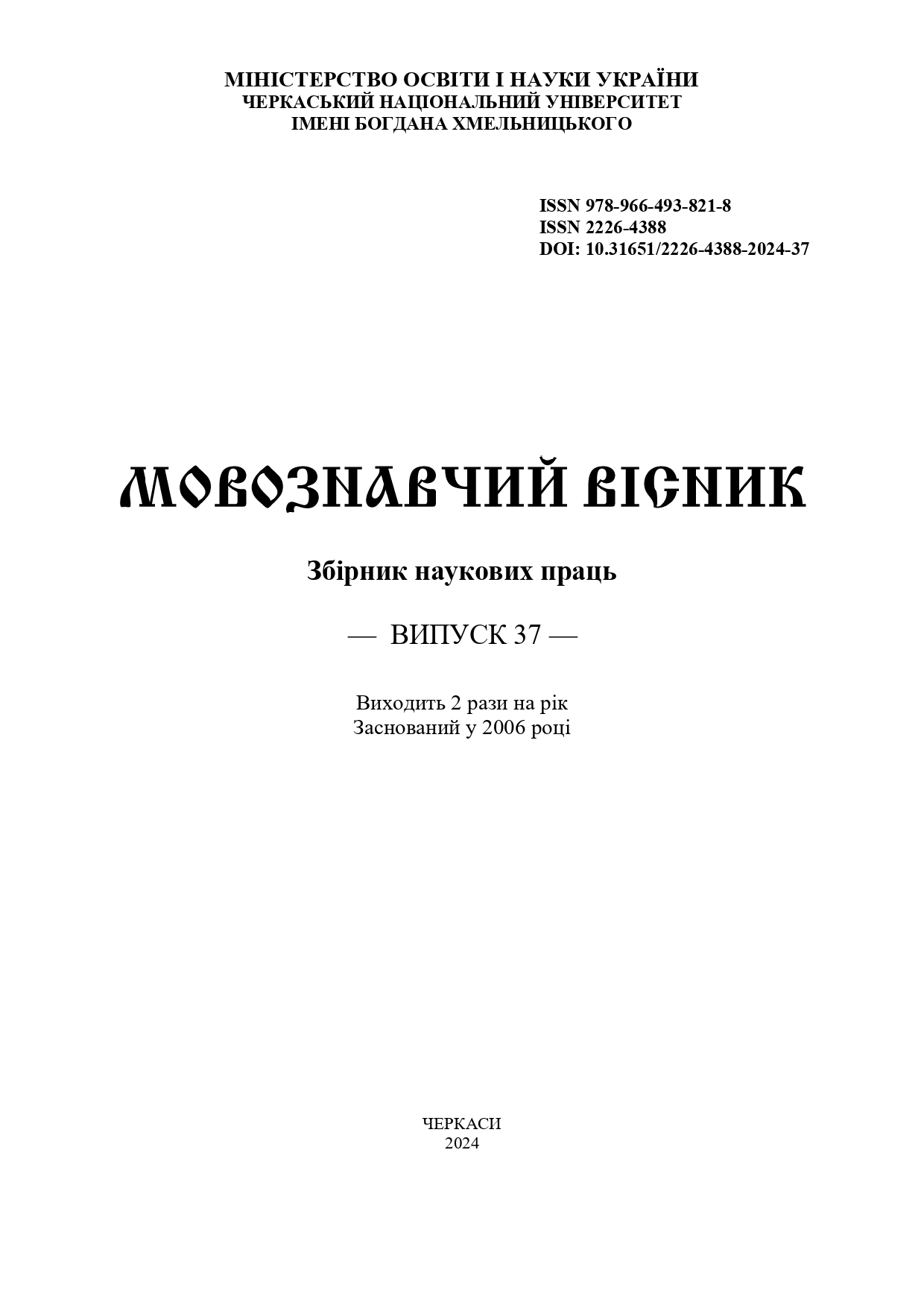UKRAINIAN PROVERBS AS TOOL OF PERSUASIVE INFLUENCE
Main Article Content
Abstract
Introduction. Persuasion contains a basic persuasive formula that consists of such components as enhancing knowledge, building confidence, stimulating desire, emphasizing need, and seeking an answer. However, researchers began to actively show scientific interest in this category only in the middle of the twentieth century, against the background of intensive development of psychology and theories related to border disciplines, for example, psycholinguistics and cognitive linguistics.
The purpose of the article is a comprehensive analysis of Ukrainian paremys as means of persuasion, a description of the main persuasive tactics in which proverbs ensure the implementation of speech influence on the interlocutor.
Main results of the study. Proverbs form the gist of what cultures consider of real concern to them, presenting cultural undesirables and desirables, all of which betray the cultural phenomena, each of which is related to the cultural models by which a society lives. Therefore, when used in speech, they carry out a communicative effect under certain conditions. Therefore, when used in speech, they carry out a communicative effect under certain conditions. Persuasion aims to bring out a shared semantic territory in the audience, a common, often hidden or unconscious, worldview. Substantially, persuasion is a cognitive process triggered or implemented by messages capable to influencing the attitudes of persons and their representation of the world. Thus, language of persuasion involves linguistic and pragmatic tools effective in influencing the collective imaginary and the feelings and beliefs of the people.
Originality. Рroverbs as a means of persuasive discourse suggest the use of various communication strategies and tools in order to convince others, namely: logical arguments, use of facts and evidence, emotional appeal, use of authoritative sources, non-verbal semiotic resources, social influence and other rhetorical techniques and tactics. To implement the persuasive strategy, the indignant speaker uses the tactics of strengthening (his/her own arguments or interlocutor’s weak points) and the tactics of diminishing (interlocutor’s arguments or his/her own weak points).
Conclusions and specific suggestions of the author. Proverbs as argumentative and rhetorical devices contribute to achieving persuasive eff ects by evoking a common cognitive ground as the basic dimension of
legitimization and identity. That persuasia and manipulation, when considered in “pure form” is the polar form of speech influence, different in means of achieving the goal: if persuasia is an open speech influence,
suggesting a deliberate choice by the recipient, speech influence with the sign “+”, then the manipulation is speech influence, often using hidden mechanisms with the aim of achieving a result, do not necessarily coincident with the interests of the recipient, speech influence with the sign “–”.
Article Details
References
Екшмідт В. Р. Мовленнєва маніпуляція: персуазивність та сугестія. Мовні і концептуальні картини
світу : зб. наук. праць. Київ, 2015. С. 275–281.
Загнітко А. П. Комунікативно-стратегічні типи мовленнєво-мисленнєвих маніпуляцій: час Ведмедика
Волдо. Записки з українського мовознавства. 2019. Вип. 26 (2). С. 203–216.
Каліщук Д. М. Концептуальні стилі англомовних політиків (на матеріалі політичного дискурсу
Дж. Буша мол., Б. Обами). Луцьк : Вежа-Друк, 2018. 192 с.
Кобченко Н. В. Семантико-прагматичний потенціал прецедентного висловлення в українському
масмедійному дискурсі. Slavia Orientalis. 2022. T. 71. № 3. S. 625–645.
Кутуза Н. В. Комунікативна сугестія в рекламному дискурсі: психолінгвістичний аспект. Київ :
Видавничий дім Дмитра Бураго, 2018. 736 с.
Левко О. Прецедентні одиниці як засоби маніпуляції в українському релігійному медіадискурсі:
психолінгвістичний вимір. Психолінгвістика. 2020. № 28. С. 99–127.
Селіванова О. О. Мовленнєвий вплив в комунікативній взаємодії. Психолінгвістика. 2012. Вип. 10.
С. 223–229.
Селіванова О. О. Світ свідомості в мові. Мир сознания в языке. Черкаси : Видавництво Чабаненко
Ю. А., 2012. 488 с.
Словник української мови. В 11 т. / ред. кол. : І. К. Білодід (голова) та ін. Київ : Наукова думка, 1970–
Т. 4. 700 с.; Т. 6. 832 с.
Blakar R. M. Language as a means of social power. Pragmalinguistics: Theory and practice. The Hague :
UP, 1979. P. 130–144.
Bruno R. Кonflikt und Konfliktlösen. Goch : BRATT, 2003. 215 s.
Claridge C. Hyperbole in English. A Corpus-Based Study of Exaggeration. Cambridge : Cambridge
University Press – Clark, 2011. 316 р.
Dijk van T. A. Discourse and manipulation. Discourse &Society. 2006. Vol. 17 (3). P. 359–383.
Elsen H. Manipulation aus sprachlicher Sicht. Wirkendes, Deutsche Sprache und Literatur in Forschung und
Lehre. 2008. Vol. 3. № 58. S. 447–466. URL : https://core.ac.uk/download/pdf/16431888.pdf.
Franke H. W. Der manipulierte Mensh. Crundlagen der Meinungsbildung. Wiesladen, 1964. 254 р.
Knape J. Modern Rhetoric in Culture, Arts, and Media. 13 Essays. Berlin ; New York, 2012. 368 р.
Lakoff R. T. Persuasive Discourse and Ordinary Conversation, with examples of advertising. Analizing
Discourse: Text and Talk. Georgetown University Press, 1982. P. 25–42.
Maslow A. Motivation and Personality. New York : Harper & Row Publishers, 1954. 411 р.
Pardo M. L. Linguistic Persuasion as an Essential Political Factor in Current Democracies: Critical Analysis
of the Globalization Discourse in Argentina at the Turn and at the End of the Century. Discourse & Society. 2001. Vol. 12
(1). P. 91–118.
Rank H. Teaching about public persuasion. Teaching and Doublespeak. Urbana, 1976. P. 3–19.
Richardson J. E. «Now is the time to put an end to all this»: Argumentative Discourse Theory and ‘Letters to
the Editor’. Discourse & Society. 2001. Vol. 12 (2). P. 143–168.
Rigotti E. Towards a typology of manipulative processes. Saussure L., Schulz P. Manipulation and Ideologies
in the Twentieth Century. Amsterdam : John Benjamins Publishing Company, 2005. Р. 61–83.

